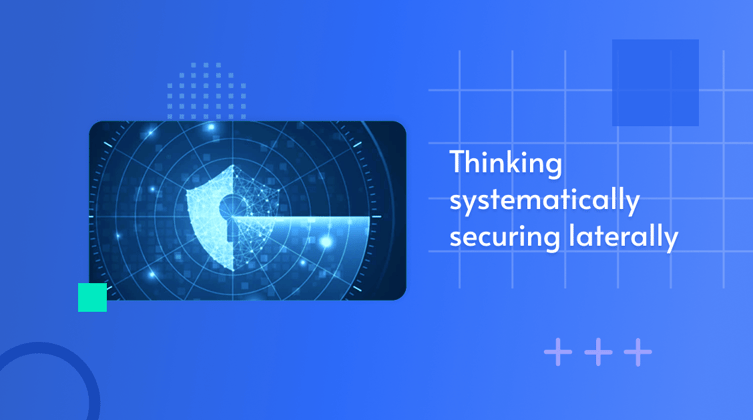Security leaders invest heavily in the front door: phishing defenses, malware de...
Lateral Movement is the Key Issue

In cybersecurity, it’s not always the initial breach that causes the most damage — it’s what happens next. Attackers today rarely stop at a single point of entry. Instead, they use advanced techniques to move laterally across systems, escalating privileges, compromising additional assets, and exfiltrating sensitive data.
Without the proper security controls, an initial compromise can quickly escalate into a full-blown incident. A CISO of a large enterprise, who spoke to us on condition of anonymity, summarized the challenge well:
"We were forced to change and we did the best we could to keep the business alive during that massive change, but we know things were missed. It would be impossible not to have had something slip by.
I worry most about where we have some looming configuration issues. That’s what a hacker will use to attack us...
We need to realize that if we don’t address the basics, and do so very well, we won’t have addressed the major problem. That’s what has been eating everyone’s lunch lately."
This statement underscores a crucial point: misconfigurations and poor security hygiene are the primary enablers of lateral movement.
Lateral Movement: A Tactical Perspective
To strengthen your defenses, start by imagining yourself as an attacker already inside the network. Ask yourself: “What is the one thing you must have to continue to own the system?” This is what we mean when we talk about thinking like a hacker. And usually you don't need to think too hard or long to know where to focus.
You'll want to quickly get a handle on:
-
What credentials and privileges are exposed
-
Network segments without strong isolation controls
-
Legacy protocols that could allow easy credential theft or relay attacks
Without strong hygiene, regardless of the way in, once they're there, it's very easy for attackers to move and maneuver through systems across infrastructure. Already under attack, that's liable to put you on the back foot— as it's hard to hit a moving target and even harden to assert ownership over a system being wormed through by an adversary.
Of course, in matters of cyber hygiene, configurations reign supreme.
Configurations as the Core Issue
Many security teams focus on perimeter defenses, but once an attacker gains a foothold, misconfigurations become their biggest ally. Some of the most common misconfigurations that enable lateral movement include:
-
Weak Credential Hygiene – Default passwords, unexpired credentials, and cached login details allow attackers to escalate privileges.
-
Overly Permissive Network Policies – Unrestricted lateral movement between network segments makes containment difficult.
-
Insecure Active Directory Configurations – Weak Kerberos settings, NTLM relay vulnerabilities, and excessive privilege delegation provide attackers with opportunities to exploit trust relationships.
-
Lack of Network Segmentation – A flat network allows attackers to move freely without triggering alarms.
-
Failure to Monitor Configuration Drift – Security settings can weaken over time due to IT changes, updates, and administrative errors, creating new attack paths.
Practical Steps to Limit Lateral Movement
To effectively reduce lateral movement, organizations should take the following actions:
-
Eliminate Unnecessary Protocols
-
Disable SMBv1, NTLM where possible, and enforce Kerberos authentication.
-
Remove legacy services that are no longer needed.
-
-
Harden Active Directory (AD) Configurations
-
Implement tiered admin access to separate privileged accounts.
-
Restrict Kerberos delegation to prevent ticket abuse.
-
Regularly audit Group Policy Object (GPO) permissions.
-
-
Implement Network Segmentation
-
Enforce Zero Trust principles, ensuring devices only communicate with necessary services.
-
Use firewalls and VLANs to create segmented environments.
-
Deploy endpoint detection tools to monitor anomalous movements between segments.
-
-
Enforce Least Privilege Access
-
Reduce local administrator accounts and enforce just-in-time (JIT) privilege escalation.
-
Regularly audit user and service account permissions.
-
-
Continuously Monitor & Remediate Configuration Drift
-
Deploy automated security validation tools that detect and correct misconfigurations before attackers can exploit them.
-
Bonus: implement Remedio’s auto-reapply function to ensure security settings remain in place even after updates or administrative changes.
-
Aiming for ASAP ASAP
By proactively eliminating misconfigurations, ensuring proper hardening, and enforcing strong security hygiene, Remedio enables organizations to stay ahead of attackers.
No matter how sophisticated an adversary may be, they rely on weaknesses in configurations to move through networks. Removing those weaknesses is the best defense.
Proof of this effectiveness can be seen in attack vectors we proactively secured before they became widely known. These include:
-
Supply Chain Attacks – Secured misconfigurations that could have facilitated breaches like SolarWinds and Keysea.
-
PetitPotam (NTLM Relay Attack) – Hardened NTLM settings before it became an industry-wide concern.
-
PrintNightmare (Print Spooler Vulnerability) – Closed this attack vector before mass exploitation.
-
Microsoft Exchange Attacks – Preemptively secured exposed configurations in Exchange environments.
There will always be threats, but Remedio is uniquely positioned to keep you ASAP ASAP — as secure as possible, as soon as possible!
About Author

Inbal Pearlson
Subscribe to
our Newsletter
We are ready to help you until and unless you find the right ladder to success.
Related Posts
Join over 25,000 in beating the failure of strategies by following our blog.
If a threat falls in the SOC and no one ties it to revenue, does it really make ...
7 minute read
Picture the legendary Metropolitan Opera House on opening night. The air hums wi...
6 minute read
In cybersecurity, the smallest missteps can lead to the biggest breaches. Take B...







Comments